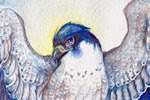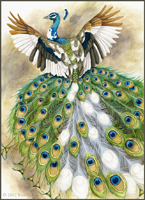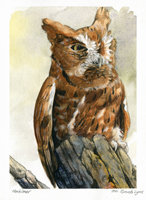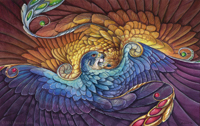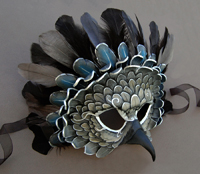Digital "Yurmby" color wheel by Fengl0ng on Deviantart, with a digital 'mask' added by myself
I've long attempted to use less color and try to focus on how to make a few colors work well together. I'm quite guilty of the 'fruit salad' approach that Mr. Gurney mentions, by using too many pure, full-saturation colors rather than mixing and focusing on a few. It seems whenever I turn to start a painting, I always go straight for the pure pigment, rarely graying anything down.
I decided to see if I could create a painting based on the limited colors of a gamut mask - that is, taking a color wheel with a 'neutral tint' at the very middle, and 'masking' a section of it to focus on those colors. In this particular color wheel, the outer colors are full-saturation, with the color gradually losing saturation nearing the center. By masking a section of this color wheel, you can focus on a small group of colors, and bar yourself from using any colors outside that wheel.
I started by mixing a neutral gray, consisting of the paint I had currently on my palette. I adjusted the gray to be as close to neutral as possible. This was the 'base' I would add to my colors to push the saturation down.
I began with a sketch of a red-tailed hawk, referenced from one of my own photos. I desaturated the photo to grayscale so I wouldn't be tempted to go with local color - I wanted to use my color theme and used the photo only for anatomy and value. For this painting, my goal was to focus on the 'points' of my gamut mask - orange and red-violet would be my main colors, with very little green or blue.
Here I used acrylic washes of my colors mixed with the neutral tint. The main color of the wings is orange (cadmium red + cadmium yellow), with a wash of a cooler red for the tail (Napthol crimson), all mixed with my neutral mixture and a little white. The dark of the wings is my neutral mixture combined with dioxazine violet. So far I have used no black - the dark value is purely from the neutral mixture with the dioxazine violet.
Once I have my overall value down, I begin adding some feather details. For the white feather edges on the back and upper wings, I don't use pure white, but mix a little with my orange/neutral mixture. It looked very dark on the white of my palette paper, but once on the darker orange of the wings, it appeared very light. This is an example of how colors can look completely different compared to their surroundings. This is something I have to remind myself when mixing colors, because I tend to go too light or too dark based on how it looks on the white of the palette paper.
Normally, I would approach this painting very differently. Knowing the natural (local) color of a red-tailed hawk, I would have used much more golden brown in the head and upper wings. I would combine a rich brown, perhaps a raw-umber combined with burnt sienna for the lower wings. The tail would be a bright crimson with yellow, and I would paint the cere and legs in a sunny ochre. In text, this sounds quite appealing, but I've found without a neutral gray to tone everything down, adding too many vibrant colors ruins the effect. The beauty of a hawk is perhaps 70% subdued tones and 30% popping color, but our brains tend to forget to pay attention to the hard-working subdued colors in favor of the fancy, royal bright tones.
To finish the painting, I added details to the feathers (neutral gray + dioxazine violet), and added very light washes of slightly more saturated color over the feet (cadmium yellow with a little bit of cadmium red) and the upper wings (my orange mixture). If found at this point, a tiny bit of color really made the figure pop. I added a bit of Napathol crimson to the gray, and painted a glaze over the dark primary feathers, which also pushed the color. But none of the colors in this painting are straight-from-the-tube full-saturation colors, and I think it resulted in a much better painting than my natural habit of using blindingly-bright colors.
The colors are not fully natural/local. This bird is a bit pinker than a natural red-tail. Compare to the reference photo below, the colors of which I did not look at, to prevent influence:
I'm actually quite pleased that my red-tail's colors were so different from a natural red-tail's plumage, but the end painting is still recognizable as a natural hawk. I may replicate this experiment using a color theme even farther than natural plumage - perhaps a green and blue-heavy gamut.
While painting this experiment, I felt my brain working in a different way than it normally does while painting - it was a feeling I haven't experienced in a while - the feeling of actively learning something new while painting. It was a great feeling! It felt a little odd while I was painting, but I had enough faith in my color scheme to know it would turn out in the end if I followed the 'rules' and didn't stray outside my color theme. I'm looking forward to my next bit of 'homework' and hope I learn even more.
There is also an immensely useful digital gamut mask tool here - http://www.livepaintinglessons.com/gamutmask.php)














